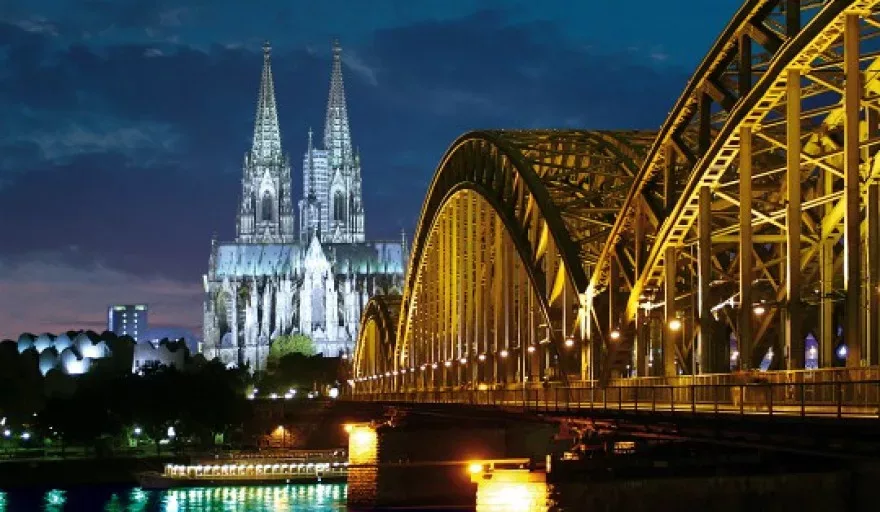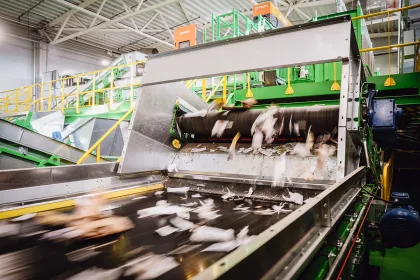Epitomising the very essence of an ideal Central European ‘city break’, Cologne thrives as the ultimate business travel destination.
Offering economic facilitation and stress-relieving leisure in equal measure, Germany’s fourth most populated city has become a popular stomping ground for every strand of visitor: whether you’re a culture vulture, a partier, an executive, a historian, a foodie, a beer connoisseur or an art enthusiast.
Cologne envelops the Rhine River to the west of the country in the Rhine-Ruhr region, and to add to its appeal even further it is renowned as one of the warmest areas of the nation despite its inevitable flood susceptibility.
For the casual tourist, its numerous eateries and bars, its relaxed and friendly people, its stunning architecture – chiefly epitomised by its world-renowned Cathedral – and its yearly winter markets make the city one of Europe’s most attractive. Yet, behind the beer and the culture, there is an equally significant sect devoted to business prevalence; making the overall culmination a business travel haven.
Cologne Convention Bureau Team Leader, Christian Woronka notes: “The framework conditions are extremely favourable: Cologne is located very centrally within Germany and Europe, and it can be very easily reached by every means of transportation; plane, train and car. In addition, as a conurbation in the federal state of North Rhine-Westphalia, Cologne has strong economic sectors and tremendous economic clout, as well as a dense network of scientific and research institutions.”
He adds: “The University of Cologne is Germany’s biggest and second-oldest university, and since 2012 it has had the status of an Excellence University with numerous international research institutes. What’s more, we have the world’s seventh-largest city centre-based trade fair complex.”
Cologne houses a broad and varied range of meeting venues, comprising 169 conference facilities all-in-all (19 event centres, 55 conference hotels and 95 event locations); amounting to more than 150,000 seats. A planned CONFEX Hall and additional array of five-star hotels in the coming years, as part of the Koelnmesse 3.0 project, will further compound the impetus too.
And naturally, such vast influxes into the city on an annual basis have a positive effect not just on the business community, but on every facet of the area’s diverse offering.
Woronka continues: “Cologne is an extremely lively metropolis that offers many opportunities to design attractive supporting programmes. This results in the very positive development of the overall number of overnight stays and of our congress and convention business. The partners in the meeting sector work hand-in-hand to promote Cologne as a destination.”
FACTS AND FIGURES
- Area: 405 square kilometres
- Population (2015): 1.06 million
- Currency: Euro (€)
- Time zone: UTC+1/2
- Dialling code: +49
- Internet TLD: .de
- Climate: Temperate-oceanic
- Highest recorded temperature: 38.8 °C
THE BUSINESS END
Geographically – and traditionally – in competition with neighbours, Düsseldorf, there is a certain amount of sharing that occurs in terms of regional prosperity, but the aftermath of numerous significant historical events have contributed more favourably to Cologne in terms of its modern infrastructure and economic influences.
Benefitting from a large market structure, the city became a dominant media base over the decades, while its academic acumen transcended into a positive reputation for fields including research, history, cultural studies and, later, finance.
“In addition to the city’s existing amenities such as event locations, hotels and infrastructure, the Cologne Convention Bureau specifically publicises Cologne’s areas of expertise in the fields of science and business,” Woronka adds as a prime example. “That mainly includes our local sector expertise in the chemical and pharmaceutical industries, the services sector, machinery and plant construction, craft workshops and the games industry.”
Numerous internationally significant companies have leveraged Cologne’s business prominence, including the REWE Group, TÜV Rheinland and Deutz AG. Once again though, an element of touristic enjoyment is never far away from the economic cycle, as one of the city’s leading exponents, Kölsch breweries epitomises all too tastefully.
The beer producer contributes to Cologne’s status of boasting the highest pub density, per capita, in Germany; inserting the final link between business and pleasure that keeps the city ticking over.
Q&A WITH THE COLOGNE CONVENTION BUREAU
Woronka’s aforementioned emphasis on event locations, hotels and infrastructure are critical when honing in on the business side of the Cologne coin. And few have been more influential in harnessing the potential of the city to this end than the Cologne Convention Bureau as he, and his colleague, Stephanie Kleine Klausing discuss.
Stephanie Kleine Klausing (SKK): Cologne has always been a prominent trade fair location, but over the years the convention business has also become increasingly important. As a result, we decided to establish a separate unit called the Cologne Convention Bureau (CCB) within the Cologne Tourist Board. This unit began operating on 1 August, 2008 in order to market Cologne specifically as a destination for congresses and conventions at the national and international levels and to build up a broad network of partners within the city.
Since inception, how has the Cologne Convention Bureau developed and progressed in terms of its key objectives and the messages it tries to get across?
SKK: We are proud of the very good development of the Cologne Convention Bureau, which will celebrate its 10th anniversary this year. A broad network of approximately 150 partners has taken shape over the years. These partners cooperate closely with the CCB to market Cologne as a destination for conventions and congresses. The networking events we organise twice a year have become a well-established component of the meeting sector in Cologne, and they are greatly appreciated as an opportunity for knowledge sharing among professionals.
Christian Woronka (CW) adds: The services offered by the CCB include a specially developed website, locations.cologne, which has been expanded over the years and is designed to be an event planner that is specially oriented toward the meeting sector. The range of services on offer at this responsive website involves all the partners of the CCB. An additional service is the Meeting Point Cologne, which started out as a simple catalogue of locations but has developed into a high-quality magazine. In addition to providing facts and figures, we use this magazine mainly to tell stories about Cologne as a congress destination, offer examples of best practice, include news about science and research and present interviews with interesting personalities.
The Cologne Convention Bureau has also adopted the German Convention Bureau’s strategy of emphasising specific areas of expertise. In addition to the city’s existing amenities such as event locations, hotels and infrastructure, the CCB specifically publicises Cologne’s areas of expertise in the fields of science and business. Especially with a view to international marketing, the CCB has formed a close partnership with the neighbouring city of Düsseldorf through ‘KölnDüsseldorf – The Metropolis’, a promotional project of the European Regional Development Fund (EFRE). The aim is to use synergies in order to establish a favourable market position for these two major cities along the Rhine.
Taking a more general industry stance, how would you evaluate the tourism sector in Cologne now compared to its condition when the Convention Bureau began?
SKK: In 2009 we introduced a regular process of market research in the congress sector, and since then we’ve been receiving valid data to work with. Back in 2009 we registered 41,500 events with 3.13 million participants. By 2016 those figures had already increased to 48,700 events with 3.82 million participants. There has also been a positive overall development in overnight stays by tourists, from 4.3 million overnight stays in 2009 to approximately six million in 2016. Congress and trade fair participants and business travellers account for a large proportion of overnight stays in Cologne. Thanks to the activities of the CCB in cooperation with its partners from the sector and the areas of science and research, we’ve been able to attract many congresses and conferences to Cologne. Examples include the World Congress of the International Academy of Pathology, which was held in Cologne in 2016 with more than 4,000 participants; the International Children’s Oncology Congress; and the International Society of Biomechanics in Sport Conference.
Looking forward, if we were to speak again in three-five year’s time, what progress and development would you hope and expect to be able to report back, both in regards to the Cologne Convention Bureau, and to the business travel industry in Cologne as a whole?
SKK: We would be delighted if the planned CONFEX Hall is completed by then as part of the Koelnmesse 3.0 project, and if a number of new five-star hotels have settled in Cologne. In addition, we would like Cologne’s popularity as a destination to continue, and we hope to attract interesting new conferences whose themes reflect the strengths of our city.
OUT AND ABOUT
“Cologne is an extremely lively metropolis that offers many opportunities to design attractive supporting programmes.” – Cologne Convention Bureau
The 10th gamescom trade fair; the Music Tourism Convention; the 19th International Congress of Classical Archaeology; the 33rd EEA Congress; the TimeRide VR Cologne; and Culinary Cologne will all complement Koelnmesse 3.0 in the coming months and years across the events, tourism and facility expansion strategy being implemented within the city.
And each new showpiece is music to the ears of Cologne’s tourism exponents. Areas of food & drink, hospitality, art & culture, nightlife, retail and museums thrive from the offshoots of business as international visitors arrive in their droves; just as eager to immerse themselves in the city’s offerings as they are to secure a new trade deal or supplier contract.
The post-war reconstruction has made Cologne the Rhineland’s cultural hub comprising more than 30 museums and hundreds of galleries. Embracing architecture from both sides of the war, contemporary blends in with Romanic splendour seamlessly and are overseen by their commanding construct, Cologne Cathedral.
As the city’s headline act, the 8,000 square metre Gothic masterpiece is poignant to visit, but is essentially a startling viewpoint from most corners of the CBD. And this fortunately means that you can combine culture and spectating with the city’s other notable pursuit: drinking.
Cologne’s annual Trade Fair and months-long carnivals keep bars full and beers flowing all year round. And even if you’d prefer to save social frivolities for the evenings, the city’s nightlife never disappoints. Little Link Bar, the Hard Rock Cafe and the Cologne Ring would be enough to induce a morning-after boardroom meeting headache on their own, but it’s still advisable to explore a little further down the ‘Straßes’ nonetheless.
OUTLOOK RECOMMENDS
Nightlife
“Various components combining to create something completely new” is the premise behind one of Germany’s most exciting bars, Little Link Bar. Its name referring to the flavour connections generated, customers can “look forward to classic drinks, excellent spirits and modern cocktail interpretations”, owner, Stephan Hinz says. The thought-out menu optimises influences from around the world and spills over into its catering arm, Cocktailkunst. “Whether it’s for 10 or 10,000 guests, tailor-made to your event, Cocktailkunst combines the best ingredients with perfect service,” the Company says. “Look forward to infused spirits, aromatic essences, fragrant foams and extravagant visuals effects!”
Accommodation
Food & Drink
The Kölsch Guys Brew House Tour
Museums
Medieval houses
Art & Culture
Retail
Hohe Strasse
Leisure
TRANSPORT LINKS
Considering the German flag carrier, Lufthansa has made Cologne its base over the years, it comes as no surprise that the city thrives as one of Germany’s leading transport hubs; the Konrad Adenauer Cologne/Bonn Airport front and centre of this status.
The likes of Ford and Toyota have similarly capitalises on Cologne’s infrastructure and location in setting up headquarters there. So, inevitably, the quality of transport in the city lives up to its cachet.
Historically is has always been an important trade city across land, sea and air; its Rhine-adjacent proximity adding a further string to this bow.
In recent years, infrastructure has understandably switched focus to the road network though; so much so in fact, that it is one of the most car-friendly cities in the country. Much like Scandinavia, many German hubs have looked to promote cycling as the foremost mode of internal transport, but the car still holds sway in Cologne and finding a reputable rental company upon arrival wouldn’t be the worst idea.
Alternately, if your travels are a little broader, then taxis can be backed up by the extensive and expectedly reliable rail offering.
Facilitating not just insular movement but national, and even continental, migration, Cologne once again flexes its central muscles. Connections to Amsterdam, Berlin, Brussels, Paris and even London are now a possibility; ultimately reaffirming the city’s role as one of Europe’s most significant touristic and business linchpins.
LANDMARK ATTRACTIONS
Cologne Cathedral
“Cologne Cathedral is a building of superlatives that is the centre and hallmark of this city on the Rhine. The cornerstone of this Gothic cathedral was laid on the Feast of the Assumption of Mary on 15 August 1248… Today the cathedral is Cologne’s second-tallest structure, surpassed only by the telecommunications tower. The cathedral covers almost 8,000 square metres of floor space and can hold more than 20,000 people. Due to the building’s impressive Gothic architecture, the shrine of the Three Wise Men, the outstanding stained-glass windows and the many other important works of art, UNESCO declared Cologne Cathedral a World Heritage Site in 1996.” – Cologne Tourist Board
The 12 Romanesque Churches
Groß St. Martin, St. Maria im Kapitol, St. Andreas, St. Aposteln, St. Ursula, St. Pantaleon, St. Gereon, St. Kunibert, St. Georg, St. Severin, Sankt Maria in Lyskirchen and St. Cäcilien make up the so-named 12 Romanesque churches.
Cologne Tourism Board details: “The churches were repeatedly altered through the centuries, and some of them were severely damaged during World War II… The successful juxtaposition of new elements, modern art, first-rate restorations and historic art and architecture fascinates the general public as well as the experts.”
Medieval City Gates
Of the initial 12 medieval city gates that once graced and guarded Cologne, only three remain: Eigelsteintor, Hahnentor and Severinstor.
“With the Severinstor, the Eigelsteintor and the Hahnentor, three of the total of twelve city gates from the mediaeval city fortifications (1180 – 1220) have been preserved and are still used today for various purposes. The smaller Ulrepforte and restored sections of the city walls are found along the Sachsenring circular boulevard,” Cologne.de explains.
KölnTriangle
“As far as the eye can see… the unique view from the KölnTrianglePanorama promises not just a special visual feast, but a treat for all the senses: feel the wind high above the rooftops, hear the muted sounds of the pulsating metropolis on the Rhine and let the vast expanse make an impression on you!
“Discover Cologne and its surroundings – with a direct view of the neighbouring Cathedral – in a way you’ve never seen it before!” – KölnTriangle Panorama


































